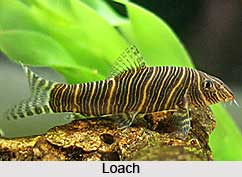 Loach is a small freshwater fish which belongs to the family Cobitidae, grows at most about eight centimetres long. The fish is thin and cylindrical in structure, with a number of barbels around the mouth. Most of the loaches are colourful with black and yellow stripes or pale yellow with black dots. Even if they are referred to as Loaches, these fishes are also called as "Thorn-eyes". They are so called because they possess one or two thorn-shaped spines which are there immediately between the eyes or almost beneath the eyes which are often erect and are used for self-defence. These are found every where in Asia, Europe, and some parts of Africa.
Loach is a small freshwater fish which belongs to the family Cobitidae, grows at most about eight centimetres long. The fish is thin and cylindrical in structure, with a number of barbels around the mouth. Most of the loaches are colourful with black and yellow stripes or pale yellow with black dots. Even if they are referred to as Loaches, these fishes are also called as "Thorn-eyes". They are so called because they possess one or two thorn-shaped spines which are there immediately between the eyes or almost beneath the eyes which are often erect and are used for self-defence. These are found every where in Asia, Europe, and some parts of Africa.
Loaches occur in shallow streams and puddles all over India usually half buried in the bottom sand. Some occur in rice fields in western India during the monsoon and are therefore called `ricefield loach`. It has a comparatively larger teeth-like bony projection below the eye by which it remains attached to the substratum. A loach Botia striata from Kolhapur and Botia lohachata from Uttar Pradesh are popular aquarium fishes.
Loaches normally feed on organic matter available at the bottom. Their breeding habits are not clearly known but the young fry, which are very tiny and colourless, quickly distribute themselves to new waters and select fields where they are a surprise to the novice. These fishes have the capacity to live in oxygen deficient waters by absorbing atmospheric air from the surface of water and moving it along its intestine in order to absorb the oxygen while the excess air is rejected out through the anus.
Loach bears a spine or spines below its eye which becomes erect when there is any threat from a predator. Barbels, possessing taste buds, are utilized to find the substrate for food. These fishes possess small scales which gives its body a `skin-like` look. These fresh water fishes are usually nocturnal or crepuscular. Some of the Loaches rest on their side for very long periods. Very little success is registered in breeding loaches in captivity and may be the recreation of the conditions of rainy season could bring on spawning.



















